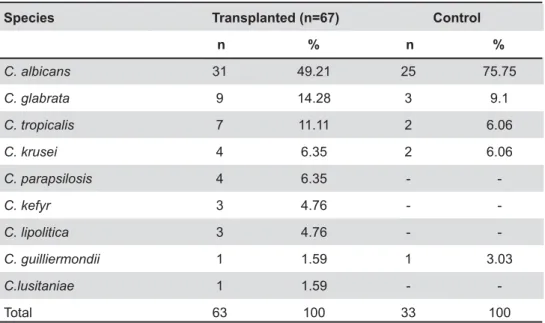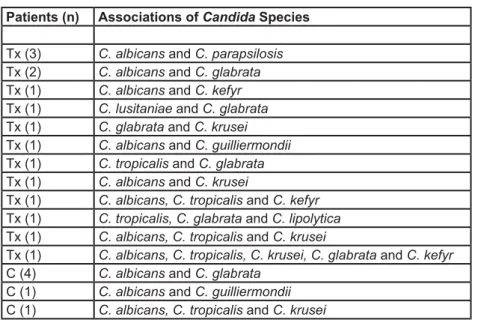ABSTRACT
Presence of Candida spp. in the oral cavity of
heart transplantation patients
Patrícia Monteiro RIBEIRO1, Fernando BACAL2, Cristiane Yumi KOGA-ITO3, Juliana Campos JUNQUEIRA3,
Antonio Olavo Cardoso JORGE3
1- PhD, Department of Bioscience and Oral Diagnosis, São José dos Campos Dental School, São Paulo State University, São José dos Campos, SP, Brazil. 2- PhD, Heart Institute (INCOR/HCFMUSP), Medical School, University of São Paulo, São Paulo, SP, Brazil.
3- PhD, Professor of Microbiology and Immunology, Department of Bioscience and Oral Diagnosis, São José dos Campos Dental School, São Paulo State University, São José dos Campos, SP, Brazil.
Corresponding address: Antonio Olavo Cardoso Jorge - Faculdade de Odontologia de São José dos Campos - UNESP - Departamento de Biociências e Diagnóstico Bucal - Disciplina de Microbiologia e Imunologia - Av. Francisco José Longo, 777, São José dos Campos - SP - 12.245-000 - Brasil - Phone: 055 12 3947 9033 - Fax: 055 12 3947 9010 - e-mail: olavojorge@fosjc.unesp.br
5HFHLYHG0D\0RGL¿FDWLRQ$SULO$FFHSWHG0D\
INTRODUCTION
Candidiasis occurs in organ transplanted patients that are in immunosuppression treatment and carriers of acquired immunodeficiency virus2,3,5,8,26,30. If disseminated, these infections are
related to high morbidity and mortality levels1,20.
Candida albicans is the etiological agent of most of oropharyngeal candidiasis cases associated with immunosuppression, although infections caused by C. tropicalis and C. dubliniensis have also been reported13,21.
A h e a r t t ra n s p l a n t p a t i e n t u n d e r g o i n g immunosuppressive therapy receives cyclosporine, azathioprine and prednisoneor tacrolimus (FK506),
C
andida spp. can lead to infections or even fungal sepsis particularly among immunocompromized individuals. Objective: The aim of the present study was to analyze the presence of Candida spp. among patients subjected to orthotopic heart transplantation. Material and Methods: Oral rinses from 50 patients subjected to orthotopic heart transplantation, aged 13 to 70 years, 40 males and 10 females, were examined. Sex-age-oral conditions matched-control included 50 individuals who were not subjected to any kind of transplantation and were not immunocompromized for any other reason. Counts of yeasts were expressed as median values of logarithm of cfu/mL and were statistically compared by Mann-Whitney’s test. The heart transplant and control groups were compared for the presence of Candida spp. by chi-square test (p<0.05). Results: The results showedCandida spp. between the
transplantation and control groups. Counts of yeasts (cfu/mL) in the transplanted group
Candida albicans was the
most prevalent species isolated from both groups. Conclusions: It was concluded that
Candida yeast counts were higher in the heart transplant recipients than in the controls. There was higher variation of Candida species among the heart transplant patients and the most frequently isolated samples were: Candida albicans, Candida glabrata and Candida tropicalis. Isolates of Candida dubliniensis was not found in either of the groups.
Key words: Candida. Heart transplantation. Oral. Fungal infections.
and rapamycin, among others10,26. The main causes
year following heart transplantation, are infection and rejection6,26. The incidence of fungal infection
in patients receiving a heart transplant varies between 10% and 25%. Extreme cases have also been reported, where the cause of death was fungal sepsis5,6.The levels of Candida spp. in the oral cavity
MATERIAL AND METHODS
Ethic Aspects
This study was approved by the Research Ethics Committee of the São José dos Campos Dental School/UNESP (060/2001 PH/CEP) and the Medical School of the University of São Paulo/INCOR/ HCFMUSP (1004/01).
Subjects
Inclusion criteria
One-hundred individuals were included in this study. Fifty patients were recipients of orthotopic heart transplantation, aged 13 to 70 years (mean age=48.6 years), 40 males (80%) and 10 females (20%). These patients received immunosuppressive therapy for a minimum period of 2 months and were under clinical follow-up at Univeristy of São Paulo Medical School’s Heart Institute (INCOR/HCFMUSP).
Sex-age-oral conditions matched control group included 50 individuals who were not subjected to any kind of organ transplantation. These individuals were aged 13 to 70 years (mean age=47.5 years), 40 males (80%) and 10 females (20%), with the closest oral conditions to those of the heart transplant patients (regarding the use of denture or orthodontic appliances). These individuals were under treatment at São José dos Campos Dental School, São Paulo State University, Brazi.
Exclusion criteria
Patients who presented clinical symptoms of oral candidiasis or were under antifungal or antibacterial therapy were excluded from the study. Patients under any kind of immunosuppressive therapy were excluded from the control group.
Oral Rinse Collection
Each individual received 10 mL of sterile phosphate-buffered saline (PBS; 0.1 M and pH 7.2) supplied in a disposable universal sterile container. They were required to mouthwash for 30 s and collect the oral rinse back into the previously ! " ice in a thermal bag, and was forwarded to the microbiology laboratory within a maximum time span of 3 h between sampling and processing. Each sample was centrifuged at 2,300 xg for 10 min (Centrifuge MPW-350R; Biosystems, São José dos Pinhais, PR, Brazil) and the supernatant was discharged. Then, the deposit was resuspended in 2.5 mL of PBS and mixed in a vortex equipment (Phoenix, model AP56, Araraquara, SP, Brazil) # suspension.
Collection of Yeast Isolates
An amount of 0.1 mL from all obtained suspensions was cultured in duplicate on Sabouraud dextrose agar (Difco Laboratories, Detroit, MI, USA) with chloramphenicol (0.1 mg/mL of culture medium)
and also in duplicate on CHROMagar (CHROMagar; Microbiology, Paris, France). Plates were incubated at 37°C for 48 h and kept at room temperature for the following 5 days. After, the number of colony-forming unities per mililiter (cfu/mL) of yeasts was calculated. Stained smears were obtained by Gram were transferred to Sabouraud dextrose agar, so as $ All cfu that showed different color or morphology in CHROMagar were isolated.
Candida6SHFLHV,GHQWL¿FDWLRQ
& $ on colonies morphology and colour observed in '*+9> & according to Samaranayake and Macfarlane24 (1990)
and Sandvén25 (1990). The following tests were
performed: germ-tube production, chlamidoconidia, hyphae/pseudohyphae production on Corn Meal agar (Difco), carbohydrate fermentation and assimilation. Orange-red colonies with Rhodotorula $
*HQRWLSLF ,GHQWL¿FDWLRQ RIC. dubliniensis
(Polymerase Chain Reaction - PCR)
& C. albicans or C. dubliniensis were subjected to molecular detection of C. dubliniensis. These isolates were analyzed by PCR, according to the methodology proposed by Donnelly, et al.7 (1999) and Mähnb, et
al.16 @ QV
were plated on Sabouraud dextrose agar and incubated for 24 h at 37°C. Then, a single colony was transferred to 75 mL of zymoliase (0.5 mg/mL) (Sigma, St. Louis, MO, USA) solution (0.5 mg/mL in 1 M sorbitol buffer). Tubes were maintained at 95°C for 10 min. After this period, samples were centrifuged at 8.000 xg at 4°C for 15 min and the supernatant was kept on ice until the PCR analyses.
F o r P C R , t w o p a i r s o f p r i m e r s w e r e u s e d : t w o u n i v e r s a l p r i m e r s , U n i - f : 5 ’ - G C ATATC A ATA A G C G G A G G A A A A G - 3 ’ a n d Uni-r: 5’GGTCCGTGTTTCAAGACG-3’; and two C. dubliniensis-specific ones, DUBF Act-f: 5’GTATTTGTCGTTCCCCTTTC-3’ and DUBR Act-r: XYZ!Z!!Z!Z!Z'['
